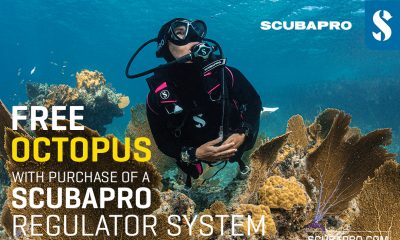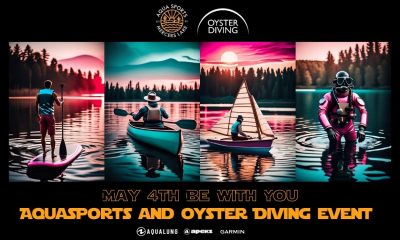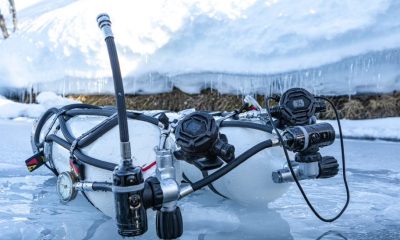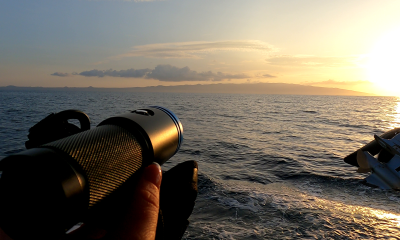News
Nauticam Announce the CMC-2 Macro Lens
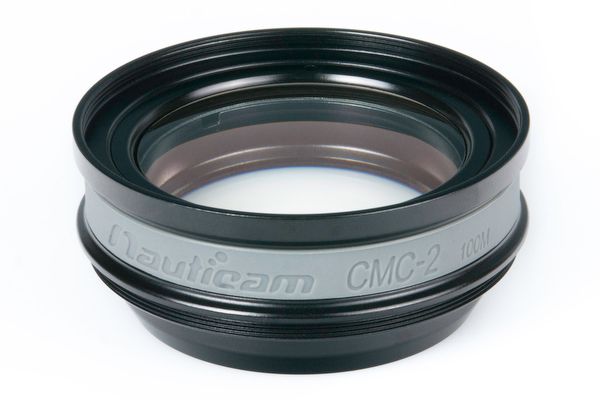
Easy to use with unmatched image quality
Nauticam has announced the immediate availability of a new macro imaging tool for compact and mirrorless interchangeable lens camera enthusiasts. The CMC-2. CMC-2 is a new macro lens designed to stand alongside the previous CMC-1, offering a less powerful lens choice for “larger” macro subjects that is noticeably easier to use.
 A little more than 18 months ago, Nauticam released THE Finest Macro Accessory Lens for Compact and Mirrorless Cameras ever made. This lens, CMC-1, became the benchmark other lenses are measured against with extremely high magnification and overall sharpness.
A little more than 18 months ago, Nauticam released THE Finest Macro Accessory Lens for Compact and Mirrorless Cameras ever made. This lens, CMC-1, became the benchmark other lenses are measured against with extremely high magnification and overall sharpness.
CMC-2 is a follow-up designed to give photographers using compact systems more magnification choices without sacrificing quality. New underwater photographers, or new system owners, will appreciate an easier to use lens with more accurate autofocus performance than stronger lenses can offer. More experienced users will find that CMC-2 is an ideal companion to CMC-1, allowing the perfect lens to be selected based on the subject size.
Improved Sharpness
During pre-production testing Nauticam noticed a stunning increase in overall image sharpness when comparing shots taken with CMC-2 to those behind a flat port (with no accessory lens at all). It became clear that with both compact cameras at full telephoto and mirrorless interchangeable lens systems the conversion lens markedly improved overall sharpness. This is counter intuitive, as conventional wisdom implies that any conversion lens reduces image quality. In this case, the flat port degrades overall sharpness, and the optical correction offered by the CMC-2 restores it. Simply put – an image taken underwater with CMC-2 is sharper than the same image taken with no accessory lens mounted. These are true water-contact corrective optics!
Breakthrough Lens Design
Prior to the development of the Nauticam accessory macro conversion lenses, achieving “super macro” underwater meant using tools that were designed for in air use. These tools simply do not take into account the physics of shooting in water. Thanks to Edward Lai, Managing Director of Nauticam, the CMC-2 takes a radically different approach: hundreds of engineering hours utilizing computer software to model an accessory lens that complements an entire system – camera, lens, port, air, and water – as a whole. This accounts for the critical air-water interfaces in a conversion lens design to achieve the best image quality possible. The improvements are stunning, measurable and a new standard in underwater macro imaging has been established with the Macro Convertor family.
 Uncompromising Optical Quality
Uncompromising Optical Quality
The CMC-2, like all Nauticam Macro Converters, is constructed from lenses precision crafted of specially formulated low dispersion optical grade glass, ground to the most demanding standards. This means greater sharpness and contrast on every shot and extraordinary resolution rivaling a macro lens used in air. Broadband anti-reflective coatings effectively reduce common optical issues such as chromatic aberrations, coma, spherical aberration, and field deformation associated with underwater macro photography using traditional magnifying lenses. This means superior light transmission, accurate color and no distortion and vignetting in the most demanding situations. These exceptional optics are assembled in a rugged hard anodized aluminum housing, and nitrogen purged during assembly to eliminate fogging.
Stunning Magnification
The CMC-2 is the less powerful of the two Nauticam Macro Converters designed for compact cameras, but magnification when compared to the capabilities of these cameras with no accessory lens is still very impressive. As an example, the popular Sony RX100 M4 can capture an image area 160mm (6.3 in.) wide at its full telephoto zoom position and minimum focus distance. With the addition of CMC-2, that image area is reduced to 55mm (2.2 in) wide. CMC-1 brings the minimum focus distance even closer, allowing a captured frame 36mm (1.4 in) wide.
Optimized for Autofocus
By utilizing a specially developed algorithm in the lens design process, the CMC-2 renders superior image quality over the full focusing range of the camera lens. This, combined with the high brightness and contrast of the image, allows the autofocus system of the camera to work well – often better than less powerful close focus lenses. Just as important are the out-of-focus (Bokeh) portions of the image that exhibit the same creamy smooth quality that photographers appreciate when shooting macro in air – all without color fringing common to traditional magnifying lenses.
Avoiding Diffraction
Due to the overall superior optical performance and precision focus of the CMC-2 it is possible to shoot larger apertures with excellent image quality. This avoids reaching the diffraction limit of high resolution sensors, and allows selective focus effects with narrow depth of field in super macro images.
Mounting and Using the CMC
The CMC-2 ships with the common 67mm threaded lens mount. The lens has a protruding rear element, designed to place the accessory optic as close to the camera lens port as is possible, providing the best overall image quality when used with flip lens adapters. A flush mount adapter ring is used when attaching CMC-2 directly to an underwater housing, and is included with the lens. Flip and Bayonet Lens Mounts are available as accessories.
Mounting Configurations
 |
 |
|
| The same Nauticam bayonet system designed with the Wet Wide Lens (WWL-1) is also compatible with CMC-2. (pn 81302.
The bayonet mounting system is the attachment method of choice for shooting both macro and wide angle on the same dive. |
Nothing beats the convenience of flip adaptors, allowing the accessory lenses to be flipped in place when needed, and conveniently swung out of the way for normal lens shooting.
A flip adaptor is the best mounting system for macro only dives, or camera systems that don’t support macro and wide angle lenses on the same dive (such as Canon G7X Mark II) |
New M67 Double Flip Holder for M67 Macro Ports, pn 25108: Allows both CMC-1 and CMC-2 to be used on the same dive for multiple macro framing options.
A word on magnification…
The industry standard macro lens magnification measure is a dioptric power, but dioptric numbers can be misleading. They are often multiple lenses stacked together, and the resulting stack doesn’t always yield the power of its individual components. In an attempt to make the power and utility of these lenses less confusing, nauticam offer a simplified magnification factor. CMC-2 offers 2.8x magnification (as an average) with compact cameras currently supported by Nauticam housings. For comparison, CMC-1 results in 4.5x average magnification.
Specifications
- Dimensions – 70mm (diameter) x 30mm (length)
- Weight – 0.22kg
- Depth Rating – 100m
- Model Number – 81302
- MSRP – $290
Attachment Accessories
Flip Lens Holder Accessories:
- 25101 M67 flip diopter holder for M67 macro ports
- 25108 M67 Double Flip Holder for M67 Macro Ports
- 25103 M67 flip diopter holder for M77 macro ports
- 25104 M67 flip diopter holder for 36121
- 25105 M67 flip diopter holder for 36137
Bayonet Mount Accessories:
- 83213 M67 to Bayonet Mount Convertor
- 83214 Bayonet Mount Adaptor for SMC/CMC
- 83215 M77 to Bayonet Mount Convertor
- 83222 Bayonet Mount Lens Holder for Arms
- 83223 Bayonet Mount Double Lens Holder for Arms
- 83227 Bayonet Mount Lens Holder for Inon Float Arms
USA: www.nauticam.com
Blogs
The Ocean Cleanup Breaks 10,000,000 KG Barrier

The Ocean Cleanup, the global non-profit project, has removed a verified all-time total of ten million kilograms (22 million lbs.) of trash from oceans and rivers around the world – approximately the same weight as the Eiffel Tower.
To complete its mission of ridding the oceans of plastic, The Ocean Cleanup uses a dual strategy: cleaning up the Great Pacific Garbage Patch (GPGP) to remove the plastic already afloat in the oceans, while stopping the flow of plastic from the world’s most polluting rivers.
Through cleaning operations in the GPGP and in rivers in eight countries, the cumulative total of trash removed has now surpassed ten million kilograms. This milestone demonstrates the acceleration of The Ocean Cleanup’s impact, while underlining the astonishing scale of the plastic pollution problem and the need for continued support and action.
While encouraging for the mission, this milestone is only a staging point: millions more tons of plastic still pollute our oceans and The Ocean Cleanup intends to continue learning, improving and innovating to solve this global catastrophe.
This announcement comes as governments from around the world meet to continue negotiations to develop a new legally binding instrument to end plastic pollution at INC4 in Ottawa, Canada. Representatives of The Ocean Cleanup will be in attendance and the organization will be urging decision-makers to collaborate towards a comprehensive and ambitious global treaty which addresses plastic at all stages of its life cycle and in all marine environments worldwide, including in areas beyond national jurisdiction.
It is encouraging to see that the need for remediation is reflected in the various options for potential treaty provisions. It is essential that the final treaty contains clear targets for the remediation of legacy plastic pollution, and reduction of riverine plastic emissions.
Tackling plastic pollution requires innovative and impactful solutions. The treaty should therefore incentivize the innovation ecosystem by fostering innovations that make maximal use of data, technology and scientific knowledge – such as those designed and deployed by The Ocean Cleanup.
‘After many tough years of trial and error, it’s amazing to see our work is starting to pay off – and I am proud of the team who has brought us to this point.’ said Boyan Slat, Founder and CEO of The Ocean Cleanup. ‘While we still have a long way to go, our recent successes fill us with renewed confidence that the oceans can be cleaned.’
The Ocean Cleanup was founded in 2013 and captured its first plastic in 2019, with the first confirmed catch in the GPGP coming soon after the deployment of Interceptor 001 in Jakarta, Indonesia. After surpassing one million kilograms of trash removed in early 2022, the non-profit project has since progressed to the third iteration of its GPGP cleaning solution, known as System 03, and a network of Interceptors currently covering rivers in eight countries, with more deployments set for 2024.
About The Ocean Cleanup
The Ocean Cleanup is an international non-profit organization that develops and scales technologies to rid the world’s oceans of plastic. They aim to achieve this goal through a dual strategy: stemming the inflow via rivers and cleaning up the legacy plastic that has already accumulated in the ocean. For the latter, The Ocean Cleanup develops large-scale systems to efficiently concentrate the plastic for periodic removal. This plastic is tracked and traced through DNV’s chain of custody model to certify claims of origin when recycling it into new products. To curb the tide via rivers, The Ocean Cleanup has developed Interceptor™ solutions to halt and extract riverine plastic before it reaches the ocean. Founded in 2013 by Boyan Slat, The Ocean Cleanup now employs a broadly multi-disciplined team of approximately 140. The foundation is headquartered in Rotterdam, the Netherlands.
For more information, visit: theoceancleanup.com and follow @theoceancleanup on social media.
Marine Life & Conservation
Steve Backshall to headline Shark Trust’s flagship event: For the Love of Sharks

Join a host of amazing, shark loving, speakers including Steve Backshall and the Shark Trust team for an evening celebrating shark conservation at the Royal Geographical Society in London this November.
Date: 29th November 2024
Time: 6-10pm
Location: Royal Geographical Society, London
Tickets: https://www.sharktrust.org/Event/flos24
The event will be a celebration of all things shark. Those lucky enough to get hold of tickets will hear from engaging guest speakers with a passion for sharks.
The line-up includes (*subject to change if unforeseen circumstances arise)
Steve Backshall: One of television’s busiest presenters, BAFTA award-winning wildlife expert Steve has been passionate about the wild world ever since he was young.
Steve’s impressive TV career has taken him all around the world, investigating a wide array of species and environments. Steve has filmed over 100 hours of children’s wildlife programmes with the BAFTA award winning Deadly 60 franchise and recently, with Sky Nature, for his new series ‘Whale with Steve Backshall’. He has been a patron for the Shark Trust for 10 years.
Simon Rogerson: is a photojournalist specialising in natural history, diving and the sea.
He is editor of SCUBA magazine, the official journal of the British Sub-Aqua Club. Simon started his career as a crime reporter but gravitated towards his ‘less depressing’ interest in underwater exploration, joining the staff of DIVE magazine in 1999. In 2005 he was named ‘Editor of the Year’ in the PPA’s Independent Publishing Awards. Simon also works as a freelance writer, contributing frequently to the Sunday Times and Telegraph, in addition to BBC Wildlife, Esquire, and a host of international diving magazines. He is the author of a book, Dive Red Sea, published by Ultimate Sports. Now based in Berkshire, Simon has been a Patron of the Shark Trust for 20 years.
More speakers to be announced soon. Head to the Shark Trust website to learn more.
The evening will also allow guests the final chance to see the Oceanic 31, shark art exhibition. Some of the artwork will be auctioned/raffled at the event, while the rest will be auctioned online to raise money for the Shark Trust Oceanic Programme.
For the Love of Sharks is an evening with something for everyone who is interested and fascinated by sharks. Join the Shark Trust, their Patrons, Trustees and Staff, along with a host of supporters for this celebration of shark conservation.
For more information or to buy a ticket: https://www.sharktrust.org/Event/flos24
-

 News3 months ago
News3 months agoHone your underwater photography skills with Alphamarine Photography at Red Sea Diving Safari in March
-

 News3 months ago
News3 months agoCapturing Critters in Lembeh Underwater Photography Workshop 2024: Event Roundup
-

 Marine Life & Conservation Blogs3 months ago
Marine Life & Conservation Blogs3 months agoCreature Feature: Swell Sharks
-

 Blogs2 months ago
Blogs2 months agoMurex Resorts: Passport to Paradise!
-

 Blogs2 months ago
Blogs2 months agoDiver Discovering Whale Skeletons Beneath Ice Judged World’s Best Underwater Photograph
-

 Gear Reviews3 weeks ago
Gear Reviews3 weeks agoGEAR REVIEW – Revolutionising Diving Comfort: The Sharkskin T2 Chillproof Suit
-

 Gear Reviews3 months ago
Gear Reviews3 months agoGear Review: Oceanic+ Dive Housing for iPhone
-

 Marine Life & Conservation2 months ago
Marine Life & Conservation2 months agoSave the Manatee Club launches brand new webcams at Silver Springs State Park, Florida




